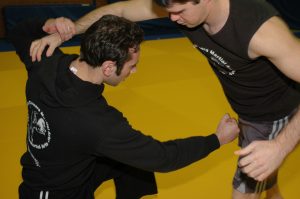
16.03.17
Tonight’s double session comprised of the third and fourth lesson of my basic self-protection course. We layered the fence by looking at offsetting a potential risk and pre-fight conflict by setting up physical angles. This was followed by revision of lineal rear-hand striking with the addition of referencing targets and incidental combinations with new techniques. Then we moved onto hook strikes and backhand strikes with an early short deviation into multiple threats. Next we covered fighting from different positions, which dovetailed into asymmetrical ground defence and kicking.
The fence concept is a constant method controlling personal space and allowing the intended target to take control of a situation before it becomes physical. Offsetting or taking a rough 45 degree angle is an effective tactic in most stages of a conflict situation. At the pre-fight stage it might even offer a psychological advantage, as the offender can subconsciously feel vulnerable. We then drilled targeting from the fence and went back over the importance of not violating the offender’s space. When the pressure is on an increased heart-rate tends to reduce to cognitive functioning. Without proper drilling of this scenario a defender is likely to go in too early or too late. In the former instance, the defender moves forward and puts his hand on the offender. This is an immediate initiation of the fight and, in this instance, the offender might have just cause to attack with his own pre-emptive strike or, if the defender, attacks first he could easily be viewed as the offender. In the latter the defender’s fence crumbles or he suddenly draws up a reduced line of attack. The offender can easily move forward with his intended attack.

We took the pre-emptive strikes on the focus mitts and once it was confirmed that my client was striking at least to the level we had established in the previously lesson, we explored referencing the target. Here the non-striking hand becomes support for the striking hand as a tactile referencing tool. Placing a hand on the offender provides the defender with an immediate connection to his target, which he should strike until the threat is removed. The uninterrupted action begins with straight shots, but as the target moves and alters – which it will – so should the trajectory of the strikes. Straight crosses become overhand strikes and finally downward hammer fists, sometimes coupled with straight or upward knee strikes. These were logical progressions that the average person often doesn’t need a lot of prompting to consider when they start thinking about where their target is going. We then isolated the overhand, the hammer fist and the straight knee strike to look at body mechanics. They were then reintegrated into the combination.
I then introduced the hook. Again, my client had a preference for punching rather than open hand strikes so we didn’t cover the notorious “power slap”. Although, this is a good opportunity to show how two drastically different looking arm techniques can be delivered using the virtually identical movements with the head, abdomen and legs, the difference needs to be addressed. Whereas an open hand hook works nicely off a response that is quite natural to humans, the hook punch is very much a trained move. Although it could be argued that the clubbing swings supposedly thrown by historical Greek pankrationists, 18th –early 19th century English pugilists, the haymakers of today and a more refined variant in Choy Lay Fut have more than a passing resemblance to a closed fist version of a power slap, an effective hook is thrown a lot tighter. We trained for this using torso twists and exaggerations of the movement before scaling it down and focusing on throwing the punch from close range.
I brought in a backhand strike, which could be used in conjunction with the hook in a Judas punch style set-up to strike a second offender. Although this had a very practical self-defence application my main reason for bringing in the action was to promote better body mechanics for the hooking action. Striking the two targets, which roughly sit on the same trajectory line, helps the student become more physically aware of the right type of momentum that needs to be created for the hook. In order to produce this action successfully there needs to be an explosive torque at the waist, engaging the oblique muscles and the hip flexors sending the kinetic energy for the strike up the legs and into a rotation. The arm moves, whip-like, towards the target.

We then began looking at different postures, where the same strike could be thrown. From a self-defence perspective each posture is a regression on the last one. This is because my main aim is to get my client back to his feet and quickly and safely as possible. This is not an absolute rule – nothing is when it comes to self-defence and its infinite numbers of variables – but it is a good basic one for most people. Addressing different postures trains the individual to have strong transitions as he tries to regain his footing. What tends to happen is that a downed person has a poor defence and an even worse counter-attack behaviour when he tries to get up off the ground. This is where a huge amount of damage can and often is inflicted.
The postures I generally use are half-kneeling, seated, posted on the side, lying on the side and on the back. We trained straight strikes from half-kneeling, seated and on the back, which were training in isolation and then as a transitional movement to standing. We trained side and round kicks from posted on the side and lying on the side and then in transition to standing. The latter provided an opportunity to focus on kicks, which I then added on the stamp and the snap kick.
Whilst on the ground we looked at a fast recovery from an asymmetrical fight. The defender covers his head and moves his feet round to face the offender’s feet, using his legs as a barriers and a counter-assault weapon.
The lesson was finished with some restrictive strike practice. We focused on the newly introduced hook, training restriction between two focus mitts and also off the wall. The hook was thrown very tight with a level elbow position.
